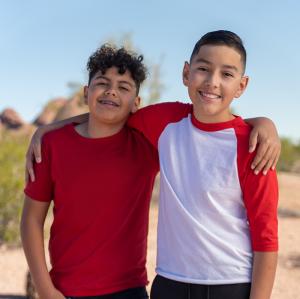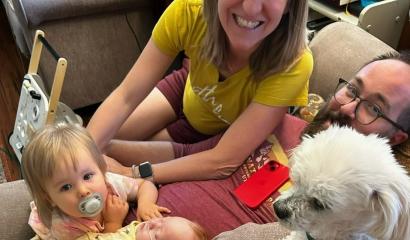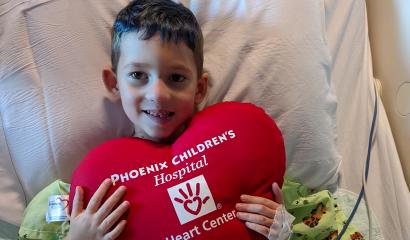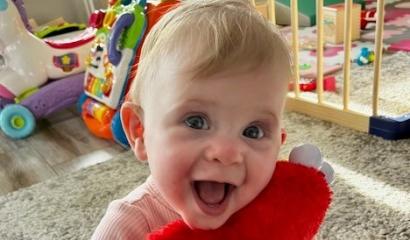Bright Futures
Articles and Updates from Phoenix Children's
Phoenix Children’s Provides Expert Guidance for 11 Years
Anna Olvera’s fourth pregnancy was going smoothly when she saw her obstetrician for a checkup and ultrasound. As a 38-year-old woman with diabetes, she was being closely monitored, and this visit was routine. The results, however, were not.
“During the test, my technician paused for a moment and took more pictures than usual,” recalls Anna. “When she left the room, I tried not to worry. When she came back with two doctors, I knew something wasn’t right.”
The doctors had detected aortic stenosis – a dangerous narrowing of the baby’s aortic valve – and they referred her immediately to the Heart Center at Phoenix Children’s, which now offers the largest fetal cardiology program in the southwestern United States.
That initial visit in 2010 was the first of many for Anna, her husband Angel, and their son, Gabriel. They did not know at the time that they were just beginning an odyssey into the world of congenital heart disease that would change their lives forever.
“Before His First Breath”
“When Anna was referred to us, Gabriel had severe aortic valve stenosis and an enlarged left ventricle (one of the heart’s chambers),” explains Christopher Lindblade, MD, medical director of the hospital’s Fetal Cardiology Program. “This is a very serious heart condition that can potentially lead to hypoplastic left heart syndrome (HLHS), in which the entire left side of the heart cannot effectively pump blood to the body.”
Dr. Lindblade recommended an immediate intervention to try to prevent the development of HLHS, using a relatively rare procedure performed in utero. He contacted colleagues at Boston Children’s Hospital, where this procedure was being done successfully.
“We took an aggressive approach in caring for Gabriel, even before his first breath,” says Dr. Lindblade. “The world of fetal cardiology is very small, and we all continually share our work and knowledge. I knew that Boston Children’s had been steadily refining a procedure to dilate – or open up – the aortic valve in utero, and the results were impressive. I recommended this option to the family.”
The Olveras flew to Boston that weekend. “It was all over in just 15 minutes,” recalls Angel. “I was amazed. The doctor said the procedure went like clockwork, but now we had to wait and see. Would his heart continue to grow?”
Five Surgeries in 11 Years
Gabriel’s heart did continue to grow, and he was born on June 14, 2010, in Boston with a full team of specialists at the ready. They whisked him immediately into the cardiac catheterization lab, where they opened up his aortic valve. One week later, he had surgery on his mitral valve – his second procedure since birth, his third overall.
In late July of that year, Gabriel and his family headed back home to Phoenix, where he became a star patient under the care of Dr. Lindblade and the extensive team of pediatric congenital heart disease experts at Phoenix Children’s.
“Gabriel is a very special kid to many people,” says Dr. Lindblade. “As he has grown, he has developed an incredibly positive outlook. He has never let his heart condition hold him back, and his parents encourage him every step of the way.”
At 10 months, Gabriel had his fourth procedure, and then in the summer of 2019 the family faced an unimaginable ordeal.
Anna’s Journey
Throughout his childhood, Gabriel regularly visited Phoenix Children’s for heart monitoring, but in 2019, something was amiss. He was having difficulty swallowing. The problem: His struggling mitral valve had narrowed and became leaky, causing a pressure buildup in his left atrium (one of the heart’s chambers). It had grown in size and was pressing on his esophagus. Gabriel was scheduled for yet another surgery in September.
Before the summer was over, however, Anna discovered that her son was not the only one with a congenital heart defect. While at work one night, Anna started feeling symptoms of an anxiety attack, something she had experienced in her 20s. This time, though, she developed chest pain and numbness, and she went to the emergency department.
She was diagnosed with an “anomalous origin of the right coronary artery.” From birth, Anna’s right coronary artery had been in the wrong place, hindering blood flow to her heart.
“At first, I was shocked, but in a split second, I realized that Gabriel’s heart defect wasn’t a fluke,” she says. “He has a family history. And my earlier anxiety attacks weren’t anxiety attacks. They were early warning signs of a heart problem.”
Anna’s surgery – called an “unroofing” – was scheduled for October with Daniel Velez, MD, co-director of the Heart Center and chief of cardiovascular surgery at Phoenix Children’s. Dr. Velez performs surgery on both children and adults as part of the hospital’s combined pediatric and Adult Congenital Heart Disease Program. Anna’s surgery would take place just one month after Gabriel’s mitral valve procedure.
“I was really feeling horrible with a lot of chest pain, but I had to try to stay calm because Gabriel was facing his own surgery,” says Anna. “I had to be there for him. It was a very difficult time.”
In September 2019, Gabriel had two more surgeries just seven days apart and recovered quickly. One month later, Dr. Velez performed Anna’s unroofing procedure to allow blood to flow to her heart without obstruction.
Today, Anna is doing well and is being cared for under the watchful eye of Wayne Franklin, MD, co-director of the Heart Center and director of the Adult Congenital Heart Disease Program at Phoenix Children’s.
Growth in Program Benefits Olveras, Hundreds of Families Across the Region
Both Gabriel and Anna have benefited tremendously from the growth of the pediatric and adult congenital heart disease programs at Phoenix Children’s.
“I began my career at Phoenix Children’s in 2006 when we had a team of nine cardiologists,” says Dr. Lindblade. “Today we have more than 20, and everyone brings an incredible level of expertise and experience to the table. From the beginning, we have been committed to a team-based, collaborative approach, with a focus on continually improving the care we provide.”
When Dr. Lindblade was named director of the hospital’s Fetal Cardiology Program in 2009, his first step was to hire a nurse coordinator who was invaluable in building the program. Together, they created a care model focused on ensuring a coordinated approach to patient care, the expansion of research and the development of advanced training programs for specialized members of the team.
Today, the Fetal Care Center at Phoenix Children’s is guided by a strategic leadership team that brings together experts in maternal-fetal medicine, neonatology, cardiology, congenital heart disease, radiology, general surgery, genetics, neurology, palliative care, perinatal pathology, and maternal psychology and psychiatry. This team of clinicians meets regularly to discuss and prepare for upcoming complex deliveries and to review cases together. Physicians from the community are invited to participate in these discussions.
“We want to support colleagues in OB/Gyn and maternal-fetal medicine, so the more we work together and share information the better the outcomes for patients,” says Dr. Lindblade.
Phoenix Children’s also sponsors a leading annual Fetal Cardiology Symposium, drawing national and international experts for presentations and discussions about the latest in congenital heart disease. This symposium supports the collaborative approach that has benefited countless children and adults with congenital heart disease across the world.
The program has advanced to such a degree that Gabriel’s latest surgery was performed at Phoenix Children’s by Dr. Velez. “By that time, Angel had kindly agreed to join our Patient and Family Advisory Council, and he could see our program’s growth and knew the expertise of our team,” says Dr. Velez. “We consulted with Boston Children’s and decided together that this time, the Olveras could stay home and still receive the best possible surgical and critical care. We replaced his struggling mitral valve with a bioprosthetic valve in 2020.”
The Olveras: Giving Back
With two of their four children still living at home, full-time jobs and unique health challenges, Anna and Angel Olvera have a great deal on their plates. But both are now active volunteers with Mended Little Hearts, an international organization supporting children with congenital heart disease and their families. Angel was just re-elected as one of the organization’s vice presidents.
“I’m the kind of person who asks a lot of questions, and during our journey, I’ve learned so much from other parents,” says Angel. “I think it’s important to share what we’ve learned to help families understand that this is a marathon, not a race. We tell parents to keep asking their questions until they are comfortable in knowing they are getting answers. And we try to provide information in a way that breaks things down as simply as possible.”
Gabriel, now 11, also has advice for kids with congenital heart disease. “Just try not to get so worried,” he says. “Stay positive so you can be in a good mental state.”
How does Gabriel stay positive? “By playing basketball,” he answers with a smile. What does he want to be when he grows up? “My first choice is to be a small forward in the NBA. My second choice is to become a doctor.”



